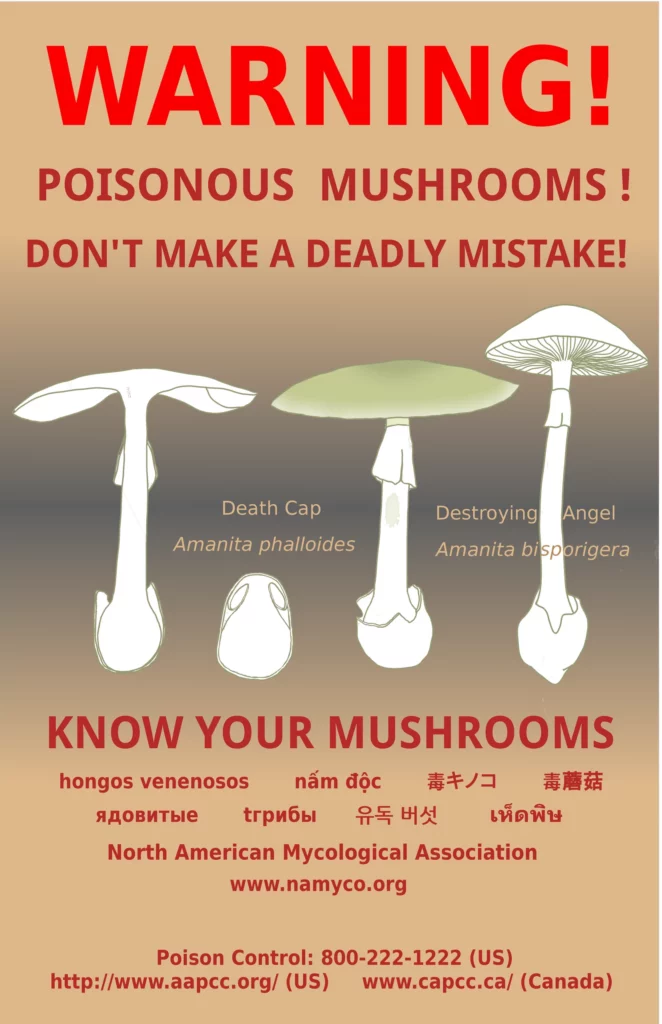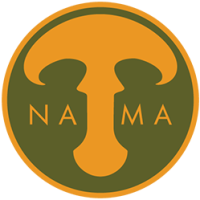Mushroom Poisonings
If You Suspect a Poisoning
If you suspect that you have consumed a poisonous mushroom, contact a physician, or your local poison control center. Once help has been secured, it is advisable to try to get the suspect mushrooms identified. NAMA provides a list of volunteers who are able to assist with identification in poisoning cases. It is best to get help if you are not familiar with mushroom identification.
What You Can Do
If you, someone you know, or even your pet may have been poisoned by mushrooms, try to get a sample of the same mushroom or mushrooms from where they were found. This will help aid in identification.
Place any available material in a paper bag or waxed paper, not plastic and refrigerate until it can be examined. Note where the mushrooms were collected in case the mushrooms may have been contaminated by uptake of pesticides or heavy metals from lawns, roadsides or industrial areas.
After the incident, help document mushroom poisonings by submitting an online report to the NAMA Poison Case Registry.
NAMA Mushroom Warning Poster

This warning poster notes the two deadly-toxic fungi, Amanita phalloides and Amanita bisporigera, responsible for the most fatal mushroom poisonings around the world. It includes warnings in several languages. Incidents of mushroom poisoning have been especially common among people who are newly arrived in North America from places where harmless lookalikes are safely and regularly harvested and consumed.
NAMA and cooperating organizations seek widespread distribution of the warning poster. The electronic version (approximately 11″ x 17″) may be downloaded and printed for educational use.
NAMA would like to thank Martha Gottleib, former Chair of the Arts & Graphics Committee (now the Visual Arts Committee), for design and artwork in creating this version of the NAMA warning poster.
Please note that paper copies of the poster are no longer available through NAMA directly, but they can be printed at a low cost by any color print shop.
Dogs and Cats and Mushrooms
Pets have been known to eat mushrooms in yards and on walks. While 99% of mushrooms have little or no toxicity, the 1% that are highly toxic can cause life-threatening problems in pets. Take extra care to keep pets away from areas where mushrooms might be growing. Immediately contact your veterinarian or the NAMA Identifiers list if you see your pet eating a wild mushroom. Try to get a sample of what your pet ate, to assist with identification. More information can be found on our Pet Poisonings webpage.
Other Resources
Listed below are a number of excellent books, literature, and websites where you can learn about mushroom identification and toxicology:
Books
- Denis R. Benjamin, Mushrooms: Poisons and Panaceas, W.H. Freeman and Company, New York (1995).
- Gary Lincoff and D.H. Mitchel, Toxic and Hallucinogenic Mushroom Poisoning: A Handbook for Physicians and Mushroom Hunters, Van Nostrand Reinhold Company, New York, etc. (1977).
- Joseph F. Ammirati, J.A. Traquair, and P.A. Horgen, Poisonous Mushrooms of Canada, Research Branch Agriculture Canada Monograph 30 (1985).
- Spoerke, David G., and Rumack, Barry H., eds. Handbook of Mushroom Poisoning: Diagnosis and Treatment. CRC Press, Boca Raton, Florida, 1994
Recent Literature
- Bakos A, Rikker C, Tóvárosi S, Kárteszi M, “[The therapeutical efficiency of the newest extracorporal elimination procedure (Prometheus(R) treatment) in acute liver failure caused by intoxication.]” Orv Hetil 2007 Oct 1; 148(42):1981-1988. (Hungarian)
- Berger KJ, Guss DA, “Mycotoxins revisited: Part I.” J. Emerg. Med. 2005 Gan; 28(1):53-62.
- Diaz JH, “Syndromic diagnosis and management of confirmed mushroom poisonings.” Crit Care Med 2005 Feb; 33(2):427-36.
- Erguven M, Yilmaz O, Deveci M, Aksu N, Dursun F, Pelit M, Cebeci N. “Mushroom poisoning.” Indian J Pediatr 2007 Sep; 74(9):847-52.
- Escudié L, Fancoz C, Vinel JP, Moucari R, Cournot M, Paradis V, Sauvanet A, Belghiti J, Valla D, Bernuau J, Durand F, “Amanita phalloides poisoning: Reassessment of prognostic factors and indications for emergency liver transplantation.” J Hepatol 2007 March; 46(3) 466-473.
- Tsutomu F, Etsuro S, Katsumi S, “Effect of Feeding with a Poisonous Mushroom Clitocybe acromelalga on the Metabolism of Tryptophan-Niacin in Rats.” Journal of the Food Hygenic Society of Japan 2001 42(3):190-196 (Japanese)
- Joshi A, Awale P, Shrestha A, Lee M, “Acute Mushroom Poisoning: a report of 41 cases.” JNMA J Nepal Med Assoc 2007 Jan-mar; 46(165):7-12.
- Karakayali H, Ekici Y, Ozcay F, Bileziki B, Arslan G, Haberal M, “Pediatric liver transplantation for acute liver failure.” Transplant Proc 2007 May; 39(4):1157-60.
- Madhok M, “Amanita bisporigera. Ingestion and death from mistaken identity.” Minn Med 2007 Sep; 90(9):48-50.
- Pawlowska J, Pawlak J, Kami?ski A, Hevelke P, Jankowska I, Teisseyre M, Szymczak M, Kalici?iski P, Krawczyk M, “[Amanita phalloides poisoning as an indication for liver transplantation in three family members].” Wiad Lek 206: 59(1-2):131-4. (Polish)
- Pradhan SC, Girish C, “Hepatoprotective herbal drug, silymarin from experimental pharmacology to clinical medicine.” Indian J Med Res 2006 Nov; 124(5):491-504.
- Puschner B, Rose HH, Filigenzi MS, “Diagnosis of amanita toxicosis in a dog with acute hepatic necrosis.” J Vet Diagn Invest 2007 May; 19(3):312-7.
- Rainone F, “Milk thistle.” Am Fam Physician 2005 Oct 1; 72(7):1285-8.
- Robertson C, Wright L, Gamiet S, Machnicki N, Ammirati J, Birkebak J, Meyer C, and Allen A, “Cortinarius rubellus Cooke from British Columbia, Canada and Western Washington, USA.” Pacific Northwest Fungi 2006 May; 1(6):1-7.
- Savius P, Danel V, “New Syndromes in Mushroom Poisoning.” Toxicol Rev 2006; 25(3):199-209.
- Yang WS, Lin CH, Huang JW, Fang CC, “Acute renal failure caused by mushroom poisoning.” J Formos Med Assoc 2006 Mar; 105(3):263-7.
- Unverir P, Soner BC, Dedeoglu E, Karcioglu O, Boztok K, and Tuncok Y, “Renal and hepatic injury with elevated cardiac enzymes in Amanita phalloides poisoning: a case report.” Hum Exp Toxicol 2007 Sep; 26(9):757-61.
- Xiao GL, Zhang CH, Liu FY, Chen ZH, Hu SY, “Clinical experience in treatment of Amanita mushroom poisoning with Glossy Ganoderma Decoction and routine western medicines.” Chin J Inter Med 2007 Jun; 13(2):145-147.
- Zhao J, Cao M, Zhang J, Sun Q, chen Q, Yang ZR, “Pathological effects of the mushroom toxin alpha-amanitin on BALB/c mice.” Peptides 2006 Dec; 27(12):3047-3052.

NAMA Store >